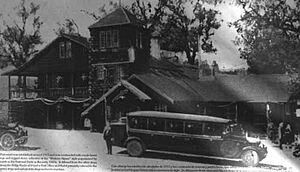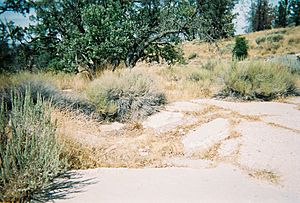Sandberg, California facts for kids
Sandberg was a small community and post office in Southern California. It was named after The Sandberg Lodge, a hotel located on the historic Ridge Route highway. This highway traveled through the Sierra Pelona Mountains and connected the Los Angeles area to the San Joaquin Valley and Central California. The Ridge Route was an important road from 1915 to 1933.
The Sandberg Lodge was destroyed by a fire in 1961. Even though the lodge is gone, Sandberg is still shown on maps of northwestern Los Angeles County. Later, the site of Sandberg also became home to a U.S. weather station.
Contents
Where is Sandberg Located?
Sandberg is about 9.7 kilometers (6 miles) southwest of Neenach, a small town in the Antelope Valley. It is about 69 kilometers (43 miles) from Downtown Los Angeles if you travel on Interstate 5.
The United States Geological Survey calls Sandberg a "populated place." This means it's an area with buildings and people living there permanently. Sandberg is located 1,269 meters (4,163 feet) above sea level. It is also about 19 kilometers (12 miles) northwest of Burnt Peak.
The Story of Sandberg
The Sandberg Family and Their Lodge
Harald Sandberg, who came from Norway, settled in the Antelope Valley in 1882 with his brother, Albert. They developed large areas of land there. In 1897, Harald claimed land for a ranch, just north of where his hotel would later stand.
In December 1900, the brothers were in the news. They had "captured a very large specimen of the California condor" on their mountain ranch near Neenach.
Harald built his lodge in 1914. This was just one year before the Ridge Route opened, bringing many cars past his front door every day. The Los Angeles Times reported that "Sandberg's lodge at the top of the grade was a welcome sight." It was a good stopping point for tired drivers from Los Angeles who were still halfway to Bakersfield.
The hotel, a restaurant, and cabins were built on land leased from the United States Forest Service. When it first opened, the business was called Sandberg's Summit Hotel and was a one-story building. After 1921, Harald turned it into a three-story log hotel. It was surrounded by live oak trees.
The lodge had a special crank telephone. This phone connected it to the outside world through long-distance lines. These lines linked Los Angeles with Bakersfield. There were also cabins behind the hotel where guests could stay.
In 1918, Harald Sandberg became the postmaster for the area. From then on, the settlement was officially named Sandberg. The post office was located right inside the hotel.
Frank Kaufman, a resident of Bakersfield, described Sandberg as a "small tourist community." It had a repair garage that was always open. Motor Stages (buses) would stop at Sandberg's for meals. Many drivers loved Mrs. (Marion) Sandberg's apple pie.
In September 1929, Ulysses S. Grant Jr., the son of the 18th American president, visited Sandberg's. He was an attorney and real estate developer. He sadly passed away from a heart attack in his room during his visit.
In the spring of 1934, the lodge was put up for sale. Harald Sandberg passed away on July 9, 1939, and his wife, Marion, died on April 1, 1954.
Changes at the Lodge
By the time Harald Sandberg passed away, new people were running the lodge. However, the hotel never became as popular as it once was. A new, alternate road to the Ridge Route opened. This new road meant that almost no traffic passed through Sandberg anymore.
J.H. Cox bought both the lodge and the ranch. According to a later owner, Walter W. (Lucky) Stevens, Cox's actions caused the hotel's good name to be hurt. Cox later sold the business to Lillian Grojean. She changed the hotel garage into a ceramics factory. Her lease from the Forest Service cost her only $90 a year.
Lucky Stevens Takes Over
Lucky Stevens was a film actor who ran a ceramics business in Burbank. He met Lillian Grojean and, in 1950 or 1951, he bought the old hotel, its other buildings, and the lease from her for $15,000.
At first, Lucky Stevens planned to add a swimming pool and a fishing pond. He wanted to reopen the property as a guest ranch. By then, the lodge was in bad shape, with pigeons living in the rafters. Eight years later, he said he wanted to open the 20-acre property as a children's ranch. He was able to get money, furniture, and used clothing for this idea.
On April 29, 1961, a fire destroyed the main lodge building. Stevens was the only person inside. A forest ranger said the fire seemed to start from sparks from the chimney. Stevens later told an interviewer that he had been burning trash when the flames began.
The Forest Service ended Stevens' lease in 1963. Today, nothing remains at the site except a historic marker, some stone steps, a small part of the foundation, and some trees and bushes.
Weather and Fire Station
In 1933, a four-person weather station was set up on the windy top of nearby Bald Mountain. This mountain is where the wet, ocean climate to the south meets a drier climate to the north. In 1953, the weather observers had to look at the instruments themselves. Then, they manually sent the information using a Teletype machine.
In 1978, the Weather Service changed to an automated station. A writer for the Los Angeles Times explained that "It was just too hard to find someone to live up in that remote region." The job was to record weather information every hour. However, in May 1981, the reporter found two people still living at the station. One was a college student who was a caretaker, and the other was a man testing a new type of wind turbine.
The only other two people living in Sandberg that month were Willard Sparks and his wife, Shirley. Willard Sparks was the captain of the Quail Lake Fire Station. He was in charge of protecting 777 square kilometers (300 square miles) of forest land. This area included Sandberg, Gorman, Pyramid Lake, part of the Angeles Forest, and a section of Interstate 5.



